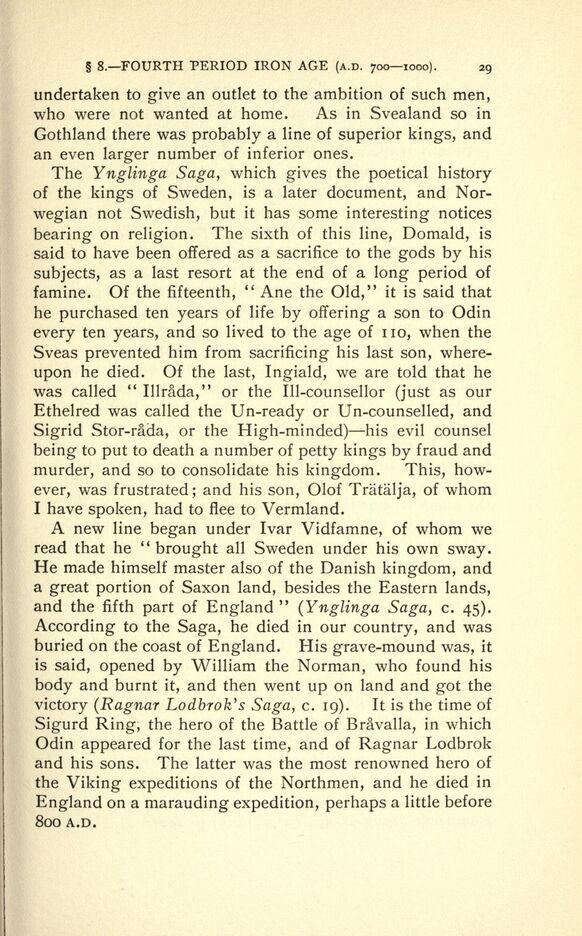
Full resolution (JPEG) - On this page / på denna sida - I. Introductory Lecture.—The Country and its Inhabitants in the Heathen Period up to 1000 A.D. - § 8. Fourth Period of the Iron Age

<< prev. page << föreg. sida << >> nästa sida >> next page >>
Below is the raw OCR text
from the above scanned image.
Do you see an error? Proofread the page now!
Här nedan syns maskintolkade texten från faksimilbilden ovan.
Ser du något fel? Korrekturläs sidan nu!
This page has never been proofread. / Denna sida har aldrig korrekturlästs.
8. FOURTH PERIOD IRON AGE (A.D. 7001000). 29
undertaken to give an outlet to the ambition of such men,
who were not wanted at home. As in Svealand so in
Gothland there was probably a line of superior kings, and
an even larger number of inferior ones.
The Ynglinga Saga, which gives the poetical history
of the kings of Sweden, is a later document, and Nor
wegian not Swedish, but it has some interesting notices
bearing on religion. The sixth of this line, Domald, is
said to have been offered as a sacrifice to the gods by his
subjects, as a last resort at the end of a long period of
famine. Of the fifteenth,
"
Ane the Old," it is said that
he purchased ten years of life by offering a son to Odin
every ten years, and so lived to the age of no, when the
Sveas prevented him from sacrificing his last son, where
upon he died. Of the last, Ingiald, we are told that he
was called
"
Illrada," or the Ill-counsellor (just as our
Ethelred was called the Un-ready or Un-counselled, and
Sigrid Stor-rada, or the High-minded) his evil counsel
being to put to death a number of petty kings by fraud and
murder, and so to consolidate his kingdom. This, how
ever, was frustrated; and his son, Olof Tratalja, of whom
I have spoken, had to flee to Vermland.
A new line began under Ivar Vidfamne, of whom we
read that he
"
brought all Sweden under his own sway.
He made himself master also of the Danish kingdom, and
a great portion of Saxon land, besides the Eastern lands,
and the fifth part of England
"
(Ynglinga Saga, c. 45).
According to the Saga, he died in our country, and was
buried on the coast of England. His grave-mound was, it
is said, opened by William the Norman, who found his
body and burnt it, and then went up on land and got the
victory (Ragnar Lodbrok s Saga, c. 19). It is the time of
Sigurd Ring, the hero of the Battle of Bravalla, in which
Odin appeared for the last time, and of Ragnar Lodbrok
and his sons. The latter was the most renowned hero of
the Viking expeditions of the Northmen, and he died in
England on a marauding expedition, perhaps a little before
800 A.D.
<< prev. page << föreg. sida << >> nästa sida >> next page >>